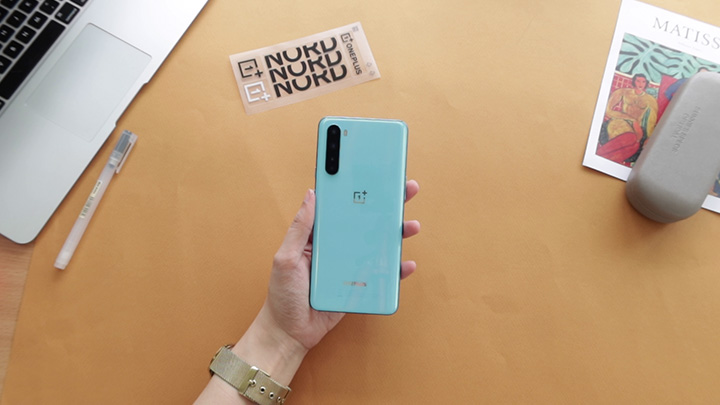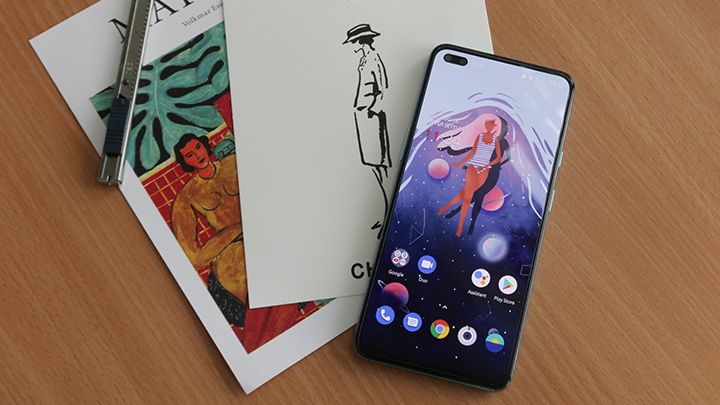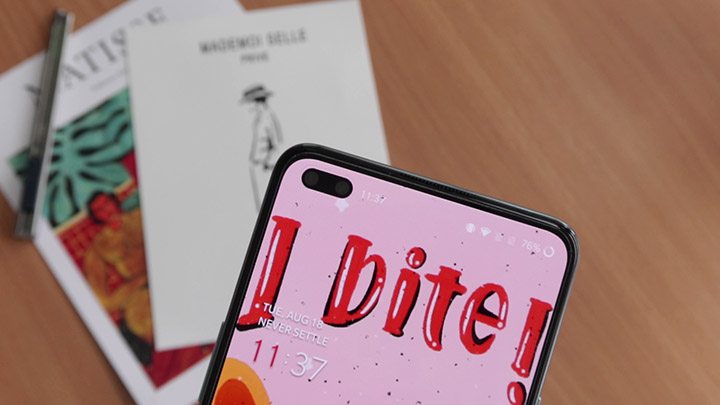Smartphone manufacturers have been releasing trimmed down variants of their flagship devices. We have the iPhone SE 2020 for Apple, the Nova 7 ESE for Huawei, and now, we have the OnePlus Nord, which is the toned-down version of the OnePlus 8. Let’s take a more in-depth look at this device and see what it’s got on its sleeves.
Table of Contents
Right off the bat, the OnePlus Nord looks very eye-catching and hype. It got a glossy back finish that’s made out of glass and protected with Corning Gorilla Glass 5. The unit we have is in Blue Marble, but it is also available in Gray Onyx, which we think looks pretty neat. Even if it has a glass build, it’s not very prone to fingerprint smudges, which is good.

In the front, we get a 6.44-inch FHD+ 90Hz Fluid AMOLED display and Corning Gorilla Glass 5 protection. SiIts Bezels are thin with a slightly thicker bottom part. Situated on the top left corner of the display is the dual-front facing cameras. You’ll also find on the screen its in-display fingerprint scanner.

On the left side, you’ll find its volume rockers.

While on the right are its power button and OnePlus’ signature three-way alert slider. They’re all tactile, clicky, and the alert slider is handy for quick sound alert control.

Up top is a noise-canceling microphone, while at the bottom are its downward-firing linear speaker, USB Type-C port, noise cancellation microphone for calls, and a dual-SIM card tray with no expandable storage option. There’s also no 3.5mm audio port here, so you’ll have to use an adapter or go wireless.

At the back, you’ll find its quad-rear cameras stacked vertically, its LED flash beside that, and some noticeable branding. In the hands, the Nord feels good to hold. It doesn’t feel hefty, and the curved sides give it a good grip. Its overall design looks pop at the same time deluxe, and it’s something you’ll easily distinguish that’s OnePlus.

The OnePlus Nord sports a 6.44-inch FHD+ 90Hz Fluid AMOLED display with a resolution of 2400 x 1080px, support for HDR10+, and a 90Hz refresh rate. Since this is an AMOLED display, the screen produces vibrant and punchy colors and deep blacks. Details are crispy and that 90Hz hits all the right spots and makes every navigating and scrolling buttery smooth.
For display customization, you can completely hide the punch-hole, adjust color temperature, and an optional vibrant color effect that enhances the colors in video playback.

Audio-wise, the downward-firing linear speaker can get pretty loud and can fill up a small room. Quality is decent enough for casual use and multimedia consumption. Unfortunately, we don’t get any 3.5mm audio port in here, so better get your favorite Bluetooth earphones or hook up an adapter to use wired headsets.
Now for cameras, the Nord has a total of four rear lenses, including a 48MP Sony IMX586 main, an 8MP ultrawide, a 5MP depth, and a 2MP macro lens. For selfies, we have a 32MP primary shooter and an 8MP ultrawide.

The camera app is packed with features, yet is still easy to use. A small thing that can take some getting-used-to is its gallery and switch camera buttons’ positioning. If you’re used to having the quick gallery shortcut on the left and the switch camera on the right, then you might get some tendency to confuse them on the Nord. Then again, its a tiny detail that you can get used to in the long run.
As for photo quality, photos taken from its rear cameras look excellent. It provides the right colors, especially under good lighting conditions, with some subtle boosting for bright hues such as green and red. Shadows and details are on point, and its 48MP shooter is as good as its standard mode, with the extra sharpness and details, of course.
It’s AI already detects night scenarios right away so you can observe minimal adjustments compared to turning the nightscape mode on.
We have no complaints with its portrait mode as it provides clean subject-background separation. And if you’re really into photography, you can maximize its Pro mode to save photos in JPG, JPG 48MP, and even in RAW files.
Selfies with the Nord look great under well-lit scenarios. With its dual front shooters, you get a wide-angle option that’s a hit or miss if you want the same color reproduction as standard selfies. This is something we found useful, especially if you’re going to take groufies.
One of the things that the Nord impressed me with is its rear camera video quality. You can shoot up to 4K at 30fps, 1080p at 240fps, and up to 4K at 30fps for timelapse. The stabilization is excellent. This video was taken from a car, yet it managed to provide smooth video output. It’s something you can surely use for vlogging.
Running the Nord is OxygenOS 10 based on Android 10. As always, we loved the OxygenOS as it is one of the best clean-looking and straightforward Android skins in the market. The UI is highly customizable, and we get the usual app drawer. There are not many pre-installed apps except for a couple of proprietary apps like the OnePlus Community app and Google apps.

You can navigate with gestures or with the usual buttons, whichever you prefer. And other nifty features you can tweak around are dark mode, app lockers, parallel apps, and reading mode. Under the settings menu, you can find the navigation bar and gesture which allows you to use gestures in exchange for the navigation bar. There’s also Pocket Mode to prevent accidental touches, as well as Digital Wellbeing and Parental Controls to add content restrictions and to keep track of your screen time.
Out of the 128GB storage, you’d get a usable 108GB storage.
Powering the OnePlus Nord is a Qualcomm Snapdragon 765G chipset coupled with an Adreno 620 GPU. Locally, we get the 8GB of RAM and 128GB of internal storage configuration. Undoubtedly, performing several tasks with this device was one heck of an experience. With its powerful internals, launching apps, playing heavy games, web browsing, and multitasking was a breeze.

Check out the benchmarks scores below:
• AnTuTu V8.4.1 – 328,190
• Geekbench 5 – 613 (Single-core), 1,984 (Multi-core)
• PCMark – 9,047 (Work 2.0)
• 3DMark – 3,302 (OpenGL), 3,087 (Vulkan)
• AndroBench – 946.1 MB/s (Seq Read), 471.74 MB/s (Seq. Write)
For biometrics, we get an in-display fingerprint scanner and face recognition, and both worked accurately and quickly. However, you might need to adjust your finger slightly lower on the screen for the fingerprint scanner.
The OnePlus Nord is packed with all the modern connectivity features, including dual-SIM support, dual-Band Wi-Fi, dual-band GPS, Bluetooth 5.1, USB 3.1 Type-C, NFC, and yes, it does support a local 5G network.

Giving energy to the OnePlus Nord is a sizable 4,115mAh battery with support for 30W Warp Charge 30T, which is very fast and can only charge the device for more or less an hour.

In our standard video loop test (1080p movie on loop, 50% brightness, 0% volume, airplane mode on), the device yielded 19 hours and 25 minutes hours. In the PCMark Work 2.0 Battery Test, it got a score of 10 hours and 58 minutes.
If you play a lot of games and use the phone most of the time with other heavy tasks, then the battery will not last you a whole day. However, it’s not that big of a deal since it charges rapidly, and if you want to save more battery, switching to a 60Hz display than the 90Hz helps.
We’re at a point where 5G capabilities in mid-range devices aren’t new anymore but are always nice to keep, just in case. For PHP 21,990, the OnePlus Nord is currently on top of my recommendations list for 5G-ready mid-rangers available today.

Besides the premium design and outstanding display, it packs excellent performance and cameras that won’t let you down. And you can always rely on its 30W Warp Charge despite its average battery capacity. But most of all, it has Google Mobile Services from the get-go.
OnePlus Nord specs:
6.44-inch FHD+ (2400 x 1080) 90Hz Fluid AMOLED display, 408ppi
Corning Gorilla Glass 5
Qualcomm Snapdragon 765G 2.4GHz octa-core CPU
Adreno 620 GPU
6GB RAM + 64GB UFS 2.1
8GB RAM + 128GB UFS 2.1
12GB RAM + 256GB UFS 2.1
Quad-rear cameras:
48MP F1.8, OIS (main)
8MP F2.3 (ultra-wide)
5MP F2.4 (depth)
2MP F2.4 (macro)
Dual-front cameras:
32MP F2.4 (main)
8MP F2.5 (ultra-wide)
Dual-SIM
5G, 4G LTE
WiFi 802.11 a/b/g/n/ac
Bluetooth 5.1
Dual-band GPS, A-GPS, GLONASS, GALILEO, BDS, SBAS, NavIC
NFC
USB Type-C
Fingerprint scanner (in-display)
Android 10 (Oxygen OS 10.5)
4,115mAh battery w/ 30W Warp Charge 30T
158.3 x 73.3 x 8.2 mm
184 g
Gray Onyx, Blue Marble

YugaTech.com is the largest and longest-running technology site in the Philippines. Originally established in October 2002, the site was transformed into a full-fledged technology platform in 2005.
How to transfer, withdraw money from PayPal to GCash
Prices of Starlink satellite in the Philippines
Install Google GBox to Huawei smartphones
Pag-IBIG MP2 online application
How to check PhilHealth contributions online
How to find your SIM card serial number
Globe, PLDT, Converge, Sky: Unli fiber internet plans compared
10 biggest games in the Google Play Store
LTO periodic medical exam for 10-year licenses
Netflix codes to unlock hidden TV shows, movies
Apple, Asus, Cherry Mobile, Huawei, LG, Nokia, Oppo, Samsung, Sony, Vivo, Xiaomi, Lenovo, Infinix Mobile, Pocophone, Honor, iPhone, OnePlus, Tecno, Realme, HTC, Gionee, Kata, IQ00, Redmi, Razer, CloudFone, Motorola, Panasonic, TCL, Wiko
Best Android smartphones between PHP 20,000 - 25,000
Smartphones under PHP 10,000 in the Philippines
Smartphones under PHP 12K Philippines
Best smartphones for kids under PHP 7,000
Smartphones under PHP 15,000 in the Philippines
Best Android smartphones between PHP 15,000 - 20,000
Smartphones under PHP 20,000 in the Philippines
Most affordable 5G phones in the Philippines under PHP 20K
5G smartphones in the Philippines under PHP 16K
Smartphone pricelist Philippines 2024
Smartphone pricelist Philippines 2023
Smartphone pricelist Philippines 2022
Smartphone pricelist Philippines 2021
Smartphone pricelist Philippines 2020